The Tomb of the First Emperor of China |Qin Shi Huang| 🤠
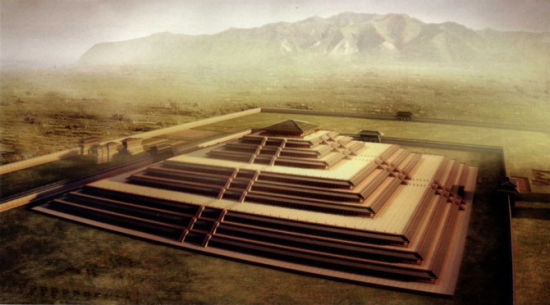
Source
According to legend, in 211 BC, a great meteor dropped in the area below the Yellow River. Someone wrote on that rock that fell from the heavens,
"The first emperor will die and his land will be divided,"
...after which, the first emperor Qin Shi Huang tried to learn more about this unusual prophecy. After no investigation found out the culprit of the murky words, all who lived near the place where the meteor had fallen were imprisoned and later executed. As early as next year, during the trip to eastern China, the first man to rule a united kingdom of China died. According to some allegations, the cause of his death was a mercury pill that was supposed to make the emperor immortal.
Qin Shi Huang was the founder of the Qin dynasty and was the first emperor of a unified China. He was born Ying Zheng or Zhao Zheng, a prince of the state of Qin. He became Zheng, the King of Qin at a young age of 13, after that, then China's first emperor when he was 38 years of age.
Once the Qin had conquered all of the other "Warring States" which was a period in ancient China history of long and bloody wars between smaller kingdoms with the goal of creating a unified China. Rather than maintain the title of "king" borne by the previous Shang and Zhou rulers, he ruled as the First Emperor of the Qin dynasty from 220 to 210 BC. His self-invented title "emperor", as indicated by his use of the word "First", would continue to be borne by Chinese rulers for the next two millennia.
During his life, the emperor was obsessed with immortality and he hoped he would create an elixir of immortality, that is, he hoped somebody could make one for him. So he gathered all the wise men and scholars in China and set them on the task of creating a potion that would make him immortal. But of course, the poor men could not grant him his wish and the emperor was left with no other option but to punish them, with the best way an emperor could, by burying them alive.
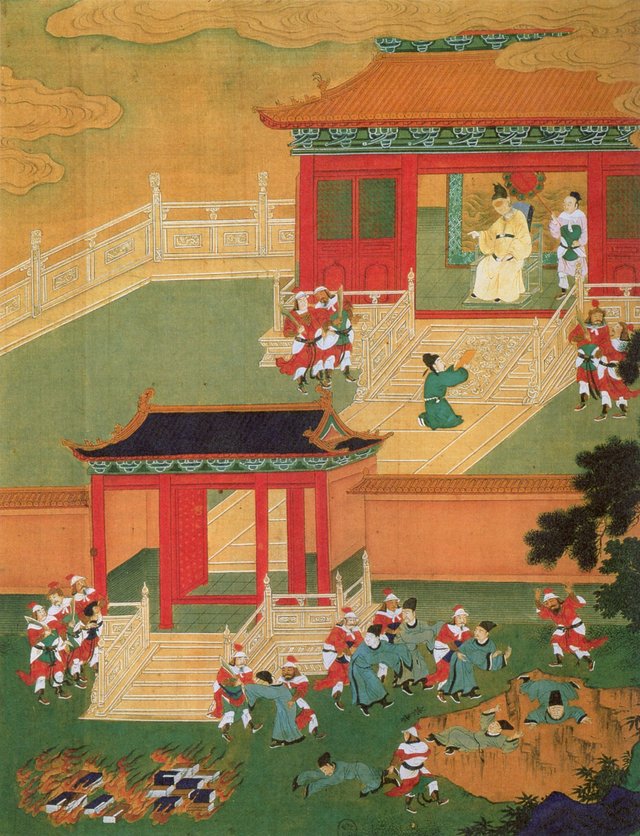
Source
After the emperor buried his scholars alive he said: "If they really have magic powers, then they will bring themselves back to life".
There are more stories about his quest for immortality but many of these are legends and there is no historical or archaeological evidence to support them.
After his ideas did not yield results he ordered his alchemists to make him medicine that would keep him healthy and would prolong his life as much as possible. One of these so-called medicines was a bottle of mercury which later killed him at the age of 49.
That tends to happen when you drink a poisonous chemical element.
Now that we understand a little about what Qin Shi Huang created and what kind of a man he was, let's get to the main part of the story.
His booby-trapped tomb filled with mystery and treasure.
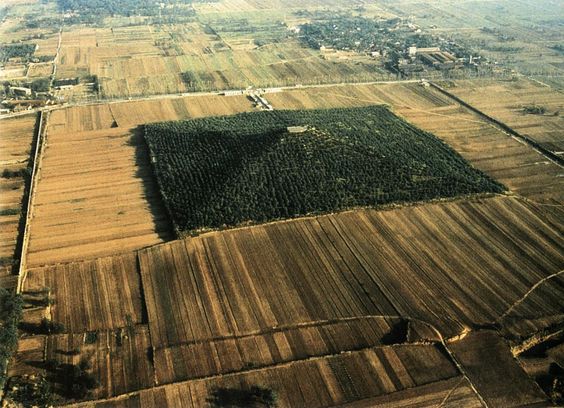
Source
Works on the emperor's tomb started around the time of his ascendance to the throne in 246 BC. when he was still a child. The full-scale construction started after he had unified China in 221 BC. The detailed account of the construction comes from Sima Qian, a Chinese historian of the early Han dynasty, in chapter six of his book: "Records of the Grand Historian", which contains the life of Qin Shi Huang:
— Sima Qian, Records of the Grand Historian, Chapter 6.
When the First Emperor first came to the throne, the digging and preparation work began on his tomb. Later, when he had unified his empire, 700,000 men from all over his empire were sent to the build site. They dug through three layers of groundwater, constructed palaces for hundreds of officials, and the tomb was filled with rare artifacts and treasure. Craftsmen were ordered to make crossbow and arrow traps to shoot at anyone who enters the tomb. Mercury was used to divert the Yangtze and Yellow River. It was suggested that it would be a serious breach in the defense of the tomb if the craftsmen who constructed the mechanical devices and knew of its treasures were to be left alive. Therefore after the funeral ceremonies had ended and the treasures hidden away, the inner passageway was blocked, and the outer gate lowered, immediately trapping all the workers and craftsmen inside. After the closing of the tomb trees and vegetations were then planted on the tomb mound such that it resembles a hill.
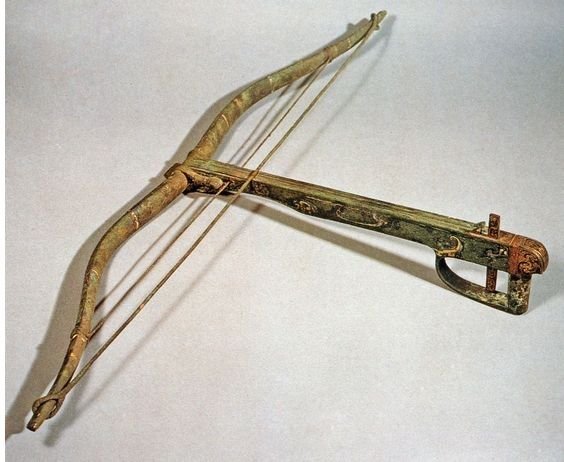
Source
It is unbelievable to me that his authority was so strong that he managed to force 700 000 people to build his tomb.
I can't even imagine in what appalling conditions they worked and lived. Another unbelievable thing that the emperor did was the creation of the terracotta army which was placed in his tomb to protect him because he feared that the six states he conquered would rise up against him. Before the tomb was shut closed, military craftsmen were ordered to make traps that would shoot crossbow bolts and arrows, this was put in place so that no looter or pesky archaeologist could enter.

Original gif, from movie: "Raiders of the lost ark"
The tomb and the secrets it contains were forgotten for almost 2000 years, until March 1974, when a group of farmers started digging a water well near the village of Xiyang. At the depth of around two meters, they found hardened dirt, then red pottery, fragments of terracotta, bronze arrowheads and terracotta bricks. It is fascinating how many of the greatest archeological discoveries are made accidentally. If only I was that lucky. 🤠
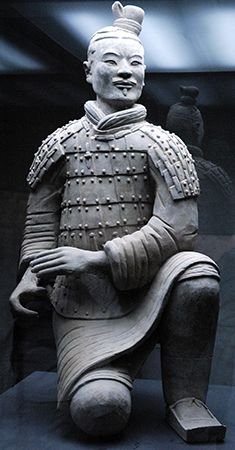
Source
The first official archaeological excavations began in may 1976, and since then large quantities of items and treasures were discovered.
There are two walls, the inner and outer wall that surround the tomb mound and a number of pits containing figures and artifacts. To the west inside the inner wall, bronze chariots and horses were found as well as terracotta figures of courtiers and bureaucrats who served the Emperor.
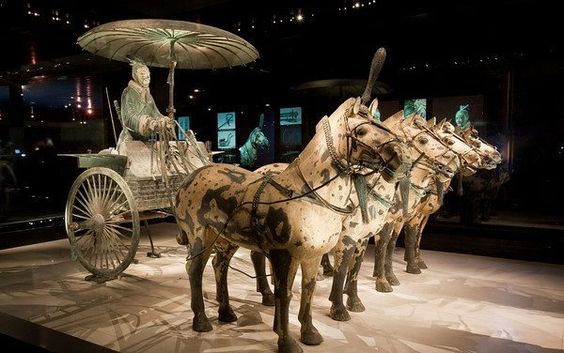
Source
Outside of the inner wall, pits with hundreds of terracotta soldiers were found, as well as a pit containing a stone suit of armor. To the north of the outer wall, an imperial park was discovered filled with bronze cranes, swan and ducks with groups of musicians placed around them. To the west of the tomb mound, a mass burial ground for the forced laborers was dug up.
The famous Terracotta Army is located about 1.5 km east of the tomb and numbers somewhere between 6000-8000 soldiers.
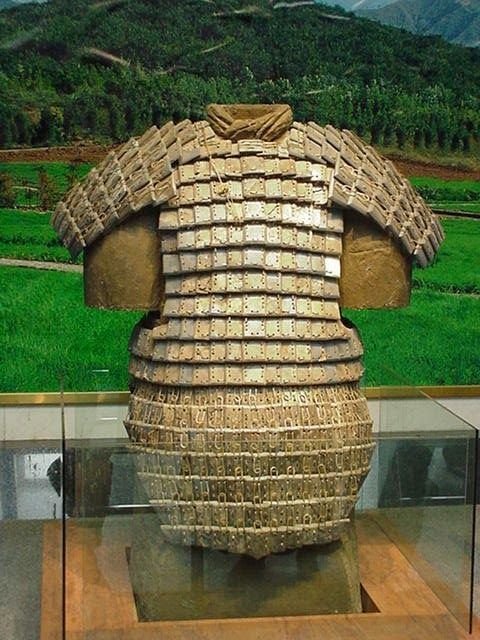
Source
This is only the tip of the iceberg because the emperor’s palace which is located in the tomb mound remains largely unexcavated, but with the help of modern technology, the inner palace where the emperor is believed to be resting was mapped using 3D volumetric scanners. Based on the findings, the courtyard-style palace was estimated to be 690 meters long and 250 meters wide, covering an area of 170,000 square meters, which is nearly a quarter size of the Forbidden City in Beijing.
The reason why the archaeologists won't enter the palace is because of high levels of mercury that have been detected in the area of the tomb mound and there are still those deadly booby-traps to think about.
Many western archeologists don't believe the traps work because the mechanisms have become so rusty that the bolts won't fire and that the wood and cords used in the traps have long since been destroyed by bacteria.
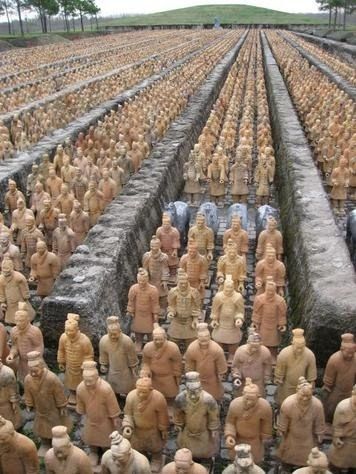
Source
Chinese historian Guo Zhikun argues the contrary he says that it is possible that the traps are still active. He claims that the use of chrome in the figures may indicate that the traps received a similar protective treatment.
But who is brave or crazy enough to try and enter the tomb with all the clearly evident dangers.
I know I'm not.
Maybe if Indiana Jones was real he and his whip would be the answer to this problem.
I guess we will have to wait until we have the required technology and skill to find out what treasures are hidden in the tomb of the first emperor of China. I just hope, when we do open the tomb we don't wake up the emperor like in the movie The Mummy: Tomb of the Dragon Emperor
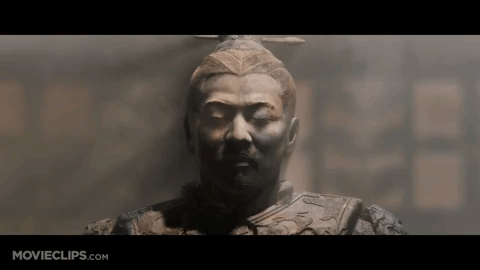
Source
Bibliography
*https://en.wikipedia.org/wiki/Qin_Shi_Huang#As_the_Emperor_of_Qin
*https://en.wikipedia.org/wiki/Mausoleum_of_the_First_Qin_Emperor
*https://listverse.com/2017/03/21/10-bizarre-tales-of-the-first-emperor-of-chinas-quest-for-immortality/
*https://gizmodo.com/5971822/archaeologists-think-hidden-imperial-tomb-may-be-too-deadly-to-explore

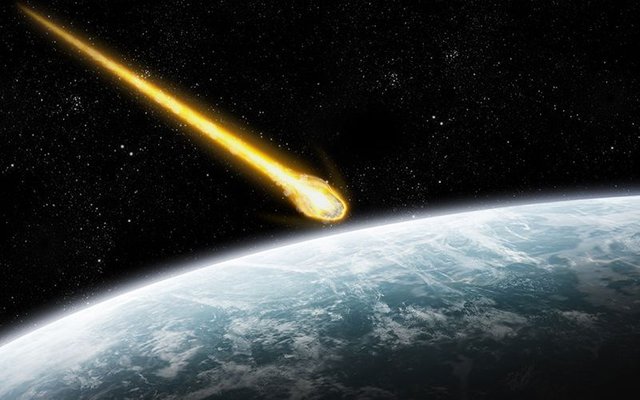
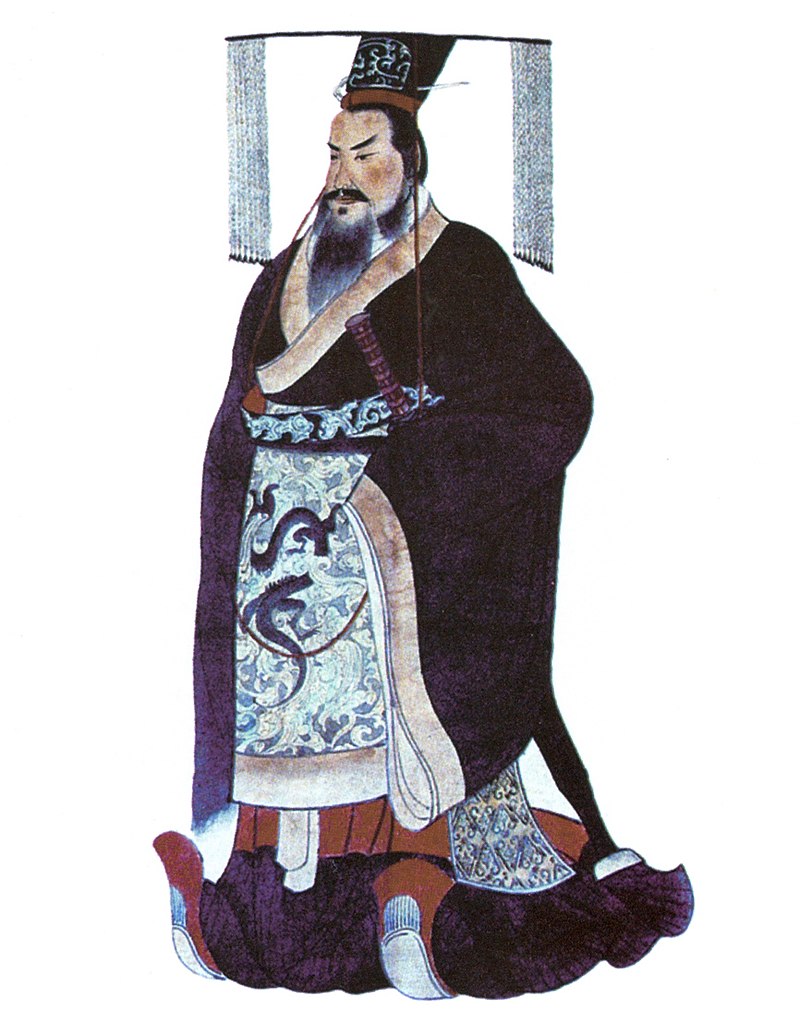
Congratulations @seltkirk! You received a personal award!
You can view your badges on your Steem Board and compare to others on the Steem Ranking
Do not miss the last post from @steemitboard:
Vote for @Steemitboard as a witness to get one more award and increased upvotes!
Didn't know that they had mercury pills so early on.
It was more of a bottle/potion, but I think they didn't know much about mercury because if they did he wouldn't have drank it like that.
Oooh, I know about this, it goes back to chinese alchemy. Gold was considered to be the key to longevity, but it was supposed to be alchemically altered gold. The belief was that you could infuse natural gold with spiritual potency by combining it with other stuff.
Enter cinnabar - it is a red (i.e. auspciously) colored mineral which, when roasted, produces mercury. This was considered magical. Now, combine it with the fact that mercury can dissolve gold and form an amalgam, and you end up with a long line of very rich ancient Chinese people slowly poisoning themselves.
Alchemy was a philosophical and proto-scientific tradition of trying to create precious metal from common ones.
But I didn't know they fused gold and mercury to create a "super potion", thanks for the history-chemistry lesson. 🤠
That's the aspect of alchemy we're familiar with, but it turns out to only be one branch of Western alchemy, which was heavily influenced by Eastern alchemy (as diffused through the mid-east).
I didn't know much about non-precious metal alchemical traditions until reading up on the history of chemistry in 'Caveman to Chemist', which has a really great set of chapters on it.
Congratulations! This post has been upvoted from the communal account, @minnowsupport, by seltkirk from the Minnow Support Project. It's a witness project run by aggroed, ausbitbank, teamsteem, theprophet0, someguy123, neoxian, followbtcnews, and netuoso. The goal is to help Steemit grow by supporting Minnows. Please find us at the Peace, Abundance, and Liberty Network (PALnet) Discord Channel. It's a completely public and open space to all members of the Steemit community who voluntarily choose to be there.
If you would like to delegate to the Minnow Support Project you can do so by clicking on the following links: 50SP, 100SP, 250SP, 500SP, 1000SP, 5000SP.
Be sure to leave at least 50SP undelegated on your account.
Amazingly detailed and wonderfully written post. 😁
Thanks 🤠
This post is 👍 ,I don't really know what I can say.You have done a great deal of research for this post. I say well done again.
This also show vanity that goes around in human mind.How can someone think he can live for eternity.and yet destroyed the life of close to a million souls.He must be somewhere to away without end.
At the same time,this post show the technology in the past
It's only recently that I've had interest in Chinese culture, and this one's making me even more curious about their history. I mean China's been around for a long time, one of the longest civilizations in the world, and they did influence a lot of other cultures.
Thanks for the interesting post!
(Though, I thought that they managed to get some of the terracotta soldiers?)
Chinese history is full of interesting and amazing stories, most of the western world does not know much about ancient Chinese history myself included and that is why I wrote this post.
They managed to excavate a few thousand Terracotta soldiers. 🤠
For a non-chinese, when you first encounter Chinese history, you'd get pretty confused, with all theie dynasties and rules and stuff, but when you get it, it's interesting. Not to mention that fact that they already had a civilized society while a majority of the world was still in developing stages.
Those soldiers, I'm curious about how they made those. I've read somewhere that no two are identical, though how they did it must have been a lot of work.
Hola @seltkirk, upv0t3
Este es un servicio gratuito para nuevos usuarios de steemit, para apoyarlos y motivarlos a seguir generando contenido de valor para la comunidad.
<3 Este es un corazón, o un helado, tu eliges .
: )
N0. R4ND0M:
9535 6289 7897 4310
5664 7442 8250 1744
9149 1879 2439 4731
4720 3111 4676 3760
Congratulations @seltkirk! You received a personal award!
Click here to view your Board